How To Take Care of a Bamboo House Plant

Welcome to the soothing universe of Bamboo House Plants – where tranquility meets greenery. In this guide, we’ll unlock the secrets to cultivating a thriving indoor oasis that elevates your space and adds a touch of Zen to your daily life.
Why Bamboo? The Beauty and Benefits 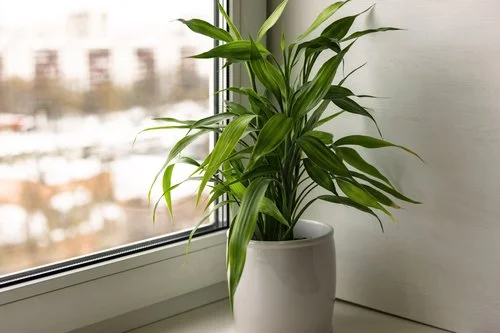
So, why choose it for your indoor haven? The answer lies in both its beauty and the myriad of benefits it offers. This plant is not merely a plant; it’s an aesthetic choice that adds a touch of elegance to your home decor.
The Beauty:
- Graceful and versatile, these house plants come in various shapes and sizes, making them suitable for any space.
- The lush green leaves and the simplicity of their structure make them visually appealing, effortlessly blending with any interior style.
The Benefits:
- Air-purifying champions: It actively filters and cleans the air, creating a healthier living environment.
- Low maintenance: Perfect for busy lifestyles, it is resilient and requires minimal care while providing maximum impact.
- Feng Shui charm: It is known for its positive energy, making it a popular choice for those seeking balance and good vibes at home.
Choosing the Right Bamboo for Your Space 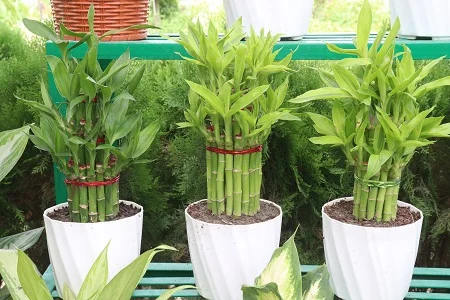
Now that we’ve dipped our toes into the tranquil waters of bamboo care, it’s time to explore the diverse world of this plant varieties and find the perfect match for your space.
Types of Bamboo House Plants
- Lucky Bamboo Varieties
Let’s start with the enchanting world of Lucky plants. These elegant, slender stems, often braided or twisted, are more than just ornamental. They symbolize good fortune and positive energy. To care for your Lucky Dracaena sanderiana, ensure it’s placed in well-draining soil or water, maintaining a balance to keep it thriving.
- Indoor Bamboo in Rocks
Looking for a chic and modern touch to your indoor greenery? Indoor plants in Rocks might be the answer. Planted in pebbles or decorative rocks, this variety adds a touch of nature to your space while requiring minimal maintenance. Our guide will walk you through the steps to ensure your bamboo in rocks survives and thrives.
- Bamboo Plants in Soil
For those who appreciate the simplicity and authenticity of soil-grown bamboo, this category offers a range of options. Plants in Soil are sturdy, adaptable, and easy to care for. Discover the essentials of maintaining soil moisture and providing the nutrients your plant craves.
Where to Place Your Bamboo Plant 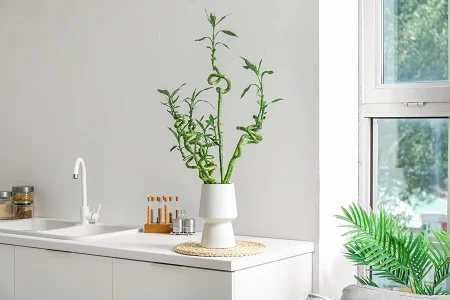
Now that you’ve chosen the perfect companion, it’s time to set the stage and find the ideal spot for your green ally. In this section, we’ll explore the art of placement, blending Feng Shui principles with the creativity of indoor landscaping.
Feng Shui Harmony: Ideal Locations
Placing it isn’t just about aesthetics; it’s about creating a harmonious energy flow within your space. According to Feng Shui, specific areas enhance different aspects of your life when adorned with bamboo:
The Wealth Corner: Place it in the southeast corner of your home or room to attract prosperity and financial well-being.
The Love Corner: Seeking to enhance your romantic life? Consider placing in the southwest corner for love and relationships.
General Placement Tips:
- Ensure your bamboo receives indirect sunlight, as too much direct sunlight can harm its delicate leaves.
- Avoid placing this plant near electronic devices or air vents that might disturb its serenity.
The Art of Indoor Landscaping: 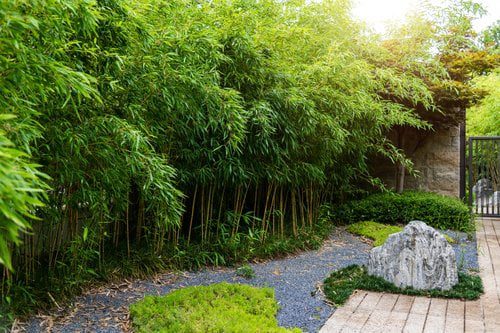
Transform your space into a green sanctuary by incorporating this plant as a centerpiece. Here’s how you can weave seamlessly into your indoor landscape:
Create Focal Points: Position it in areas that can be a focal point, drawing attention and admiration.
Combine with Other Elements: Pair bamboo with complementary indoor plants, creating a dynamic and visually appealing arrangement.
Enhance Your Decor: Use it to accentuate your existing decor, bringing a touch of nature into modern or classic settings.
Lucky Bamboo House Plant Care 
Welcome to the enchanting world of Lucky plants, where simplicity meets elegance, and prosperity is just a leaf away. In this section, we’ll unravel the secrets of their care, explore the basics, offer stylish tips for arrangement, and delve into the art of watering for prosperity.
The Basics of Lucky Bamboo
Lucky Bamboo Essentials:
- Scientifically known as Dracaena sanderiana, is not technically bamboo but shares its resilient and easy-care qualities.
- Place it in a clear vase with water or in well-draining soil, ensuring the roots are submerged.
- Indirect sunlight is the key; it thrives in low to moderate light conditions.
Symbolism and Superstitions:
- According to Feng Shui, the number of stalks in this plant can attract different types of luck.
- Three stalks symbolize happiness, wealth, and longevity, while five attract positive energy.
Stylish Tips for Arranging Lucky Bamboo 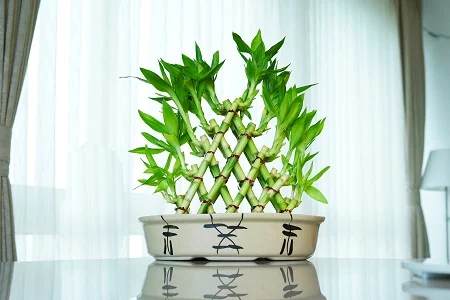
Lucky Bamboo as Decor:
- Elevate your space by arranging this as a centerpiece or accent piece.
- Experiment with different vase styles, pebbles, or decorative rocks to add a touch of flair.
The Art of Braiding:
- Showcase your creativity by braiding multiple Lucky Bamboo stems for a unique and stylish look.
- Weaving not only adds aesthetic value but also promotes thicker, healthier growth.
How to Grow Bamboo Indoors in Water: A Step-by-Step Guide 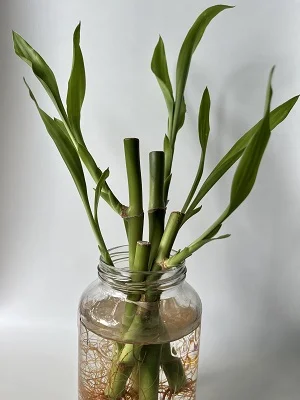
Unlock the secrets to thriving Dracaena sanderiana growth as we cultivate these graceful green companions in water. Follow this step-by-step guide and discover tips for maintaining optimal water quality to ensure their flourishes in vibrant health.
Step 1: Choose the Perfect Vessel
Select a clear vase or container that complements your style and allows an unobstructed view of your bamboo’s intricate root system. Ensure the container has enough depth to accommodate the roots comfortably, providing ample space for them to stretch and grow.
Step 2: Fill with Filtered or Distilled Water
Water quality is paramount for your bamboo’s well-being. Fill the chosen vessel with filtered or distilled water to prevent mineral build-up that can hinder growth. Avoid using tap water with high mineral content, as it may compromise the health of your plant over time.
Step 3: Select the Right Bamboo Variety
Different varieties may have specific preferences for water cultivation. Choose a bamboo species well-suited for growing in water, such as the ever-popular Dracaena sanderiana. Research the particular requirements of your chosen their variety to ensure optimal care.
Step 4: Position in Indirect Sunlight
Place your water-growing Dracaena sanderiana in an area with indirect sunlight. While it thrives in low to moderate light conditions, avoid exposing it to harsh, direct sunlight, as this can scorch the leaves and hinder healthy growth.
Tips for Maintaining Water Quality and Promoting Healthy Growth: 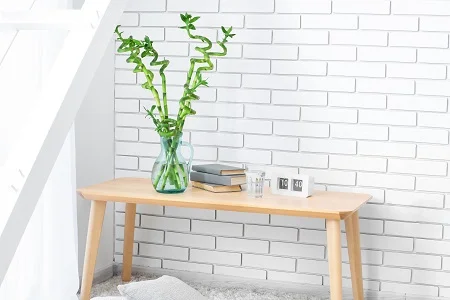
- Change the Water Every 2-4 Weeks:
- Ensure a fresh and nutrient-rich environment for your bamboo by changing the water regularly.
- This simple step prevents stagnation and promotes a conducive atmosphere for their roots.
- Introduce Balanced Liquid Fertilizer:
- Support healthy growth by adding a diluted, balanced liquid fertilizer every 2-4 weeks during the growing season.
- The proper nutrients will enhance its vitality, ensuring it remains a vibrant addition to your indoor oasis.
Growing indoors in water is not just a cultivation method; it’s a captivating journey into the elegance of nature. Stay tuned for more insights on lucky bamboo care and watering your house plant as we nurture the green beauty within your living space.
Troubleshooting: Watering Woes and Solutions
Mastering the art of watering is crucial in the quest for the perfect indoor oasis. Join us as we troubleshoot common watering issues, recognize signs that they needs a sip, and strike the delicate balance between overwatering and underwatering. Adapt to your bamboo’s seasonal needs and ensure your green companions thrive in every climate.
Signs Your Bamboo Needs Watering
- Wilting Leaves:
- If you notice your Dracaena sanderiana leaves looking droopy or limp, it’s a clear cry for hydration.
- React promptly to restore vigor by providing a thorough watering.
- Yellowing Leaves:
- Yellowing leaves can signal both overwatering and underwatering.
- Pay attention to the soil or water condition and adjust accordingly.
- Dry Soil:
- Stick your finger into the soil or water. If it feels dry, it’s time to water your indoor plant.
- Consistently dry conditions can lead to stress and hinder healthy growth.
Overwatering vs. Underwatering: Striking the Balance 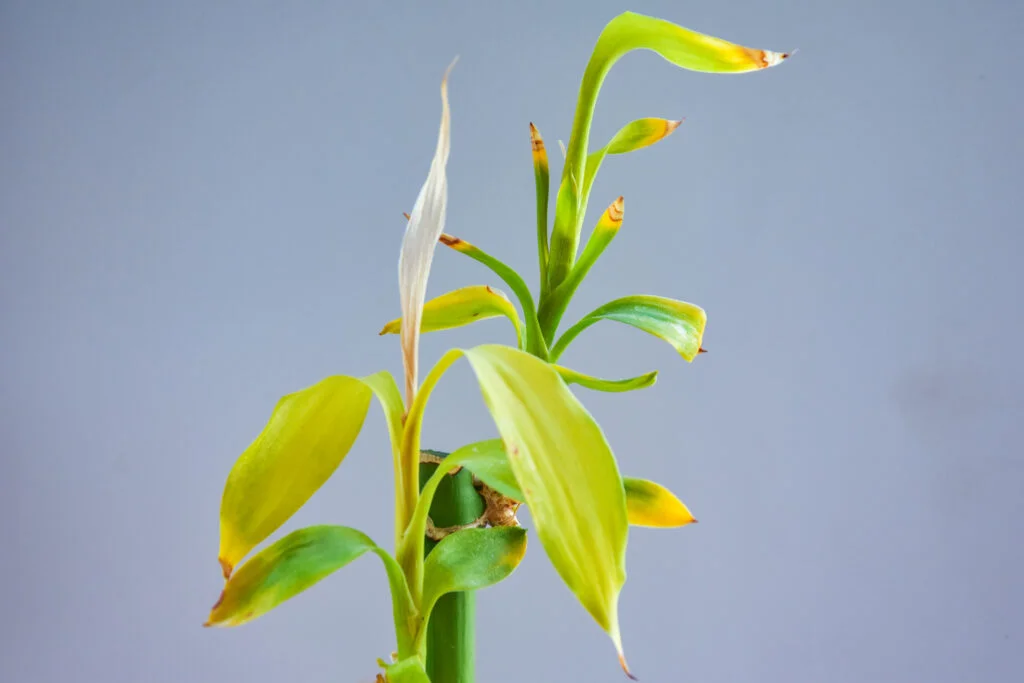
- Signs of Overwatering:
- Wilting despite moist soil may indicate root rot from overwatering.
- Yellowing leaves coupled with soggy soil is a clear sign of excess water.
- Signs of Underwatering:
- Dry soil and crispy, brown edges on the leaves suggest insufficient water.
- Thirsty plants may exhibit slow growth and a generally unhealthy appearance.
- Striking the Balance:
- Tailor your watering routine to your plant’s needs, considering factors like humidity, temperature, and the chosen growing medium (soil or water).
- Allow the top inch of soil or water to dry before the next watering, preventing both extremes.
Seasonal Adjustments: Adapting to Your Bamboo’s Needs
In Spring and Summer:
- Increased growth during these seasons often requires more frequent watering.
- Monitor soil or water moisture levels regularly to ensure your bamboo stays hydrated.
In Fall and Winter:
- With reduced growth, scale back watering to prevent waterlogged soil.
- Adjust your routine based on environmental changes to maintain a balanced hydration level.
The Bottom Line
As we wrap up our bamboo care odyssey, you’ve gained the skills to transform your living space into a verdant sanctuary. From understanding the nuances of lucky plant care to mastering the delicate dance of watering, your pant sanctuary is destined for greatness. Keep the plant spirit alive, and may your home echo with the serene greenery notes. Your indoor oasis awaits, and their symphony continues to flourish!












